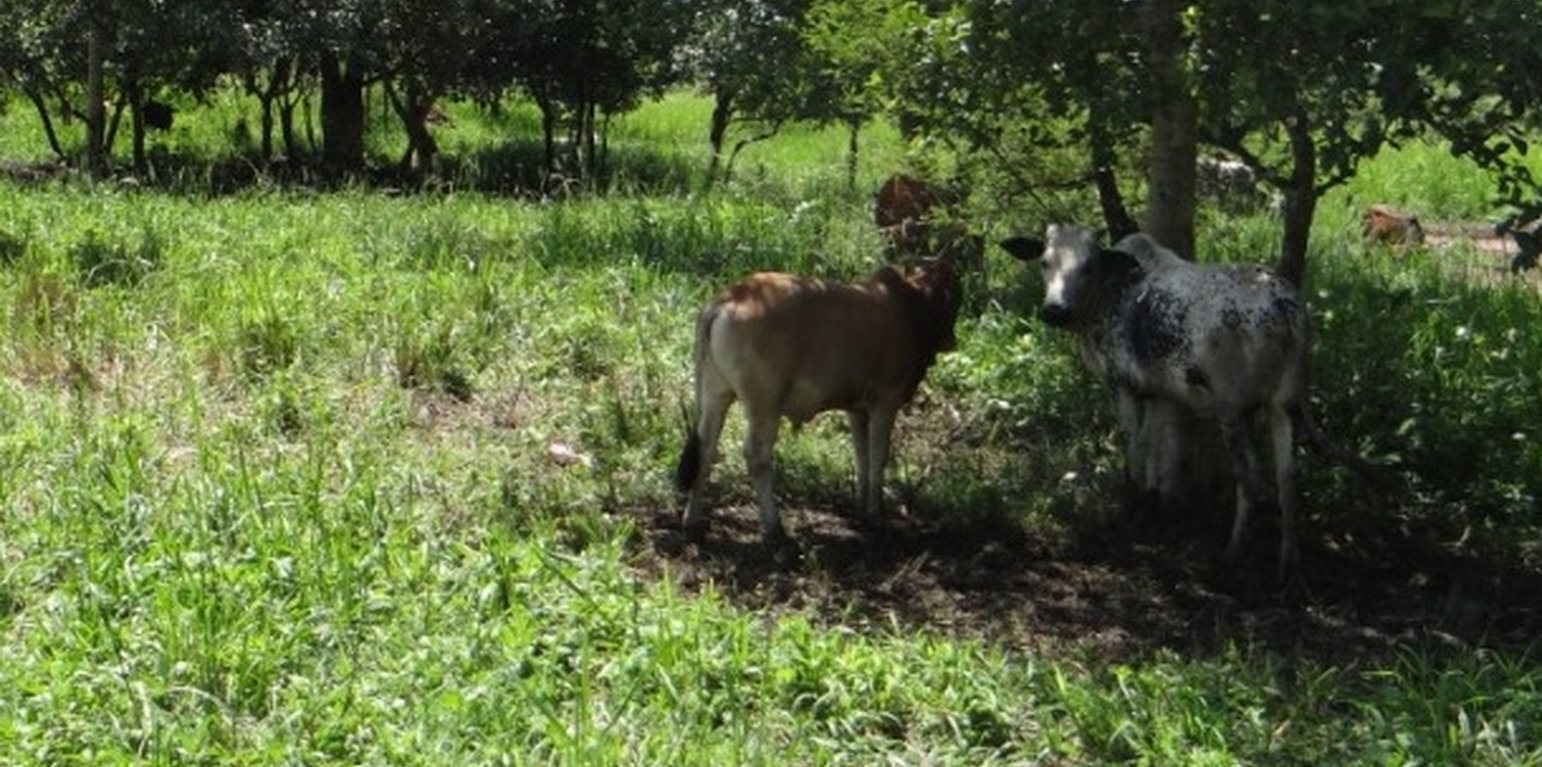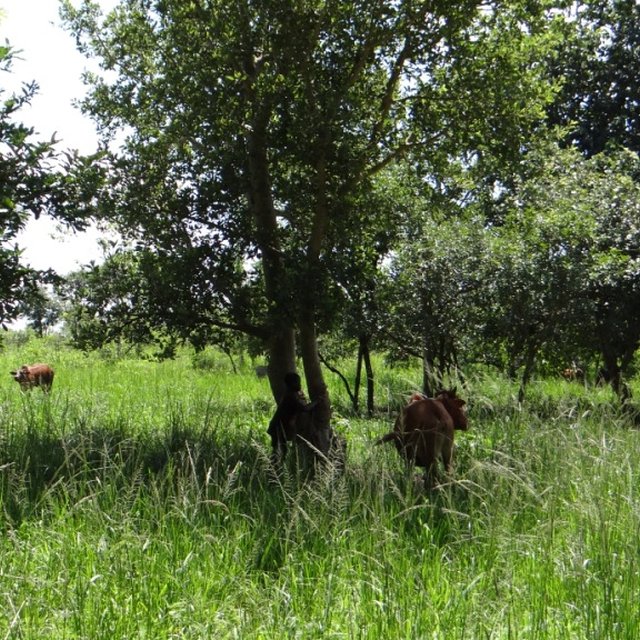



Controlled livestock grazing is a common practice promoted by farmers in Northern Uganda, who own up to 4-6 cows raised on two or more acres of land. Although the primary purpose is to produce milk for domestic consumption and for sale, the other subsidiary aim is to generate manure to replenish soil fertility on continuously cultivated and nutrient depleted land and pasture that the cows graze on. During the rainy season crops are planted and animals fed by cut and carry or pegged/ tied with a radius of 2-5 meters. During dry season the animals can graze on crop residues
For this technology, cattle are tethered/ tied on a pole (pegged) or tree using a sisal rope. Tethering distance should allow each cow to access pasture uninterrupted by others. The animals are rotated/ relocated routinely to minimise overgrazing in a given location. The manure produced is collected daily, and kept in heaps to compost for periods of 2 to 3 weeks, before being ferried to the fields for application for the cultivation of maize and other crops like soya bean . This technology requires possession of sufficient land for grazing the animals, as well as sufficient labour for handling manure through composting up to field application. The key inputs required for establishing this technology include labour, hand hoes, spades, sisal ropes, basins, sacks and basket for collecting manure and its transportation to the maize field, watering containers , spraying pumps for spraying animals against ticks and feeds to supplement the grazing during shortage of pasture.
The benefits derived from such a technology are both short and long term, including access to increased manure to apply on crop fields especially maize for increased production
To replicate this technology, the land user needs to have knowledge and skills on how to manage the animals to generate high quality manure, compost it and maintain it free of contamination with pesticides sprayed on the animals against pests and diseases, which may affect the quality of the manure and the safety of the users.

Lieu: Gulu Municipality, Gulu District, Northern Region, Ouganda
Nbr de sites de la Technologie analysés: site unique
Diffusion de la Technologie: répartie uniformément sur une zone (approx. < 0,1 km2 (10 ha))
Dans des zones protégées en permanence ?:
Date de mise en oeuvre: 2012; il y a moins de 10 ans (récemment)
Type d'introduction

| Espèces | Nombre |
| bétail - laitier | 5 |



| Spécifiez les intrants | Unité | Quantité | Coûts par unité (UGX) | Coût total par intrant (UGX) | % des coût supporté par les exploitants des terres |
| Main d'œuvre | |||||
| Planting | persons | 2,0 | 150000,0 | 300000,0 | 100,0 |
| Tieing, feeding and grazing cows | persons | 2,0 | 150000,0 | 300000,0 | 100,0 |
| Equipements | |||||
| Hoe | pieces | 1,0 | 10000,0 | 10000,0 | 100,0 |
| Spade | peices | 1,0 | 10000,0 | 10000,0 | 100,0 |
| Spraying pump | pieces | 1,0 | 250000,0 | 250000,0 | 100,0 |
| Watering trays | pieces | 6,0 | 100000,0 | 600000,0 | 100,0 |
| Matériel végétal | |||||
| Maize seed | Kgs | 10,0 | 2500,0 | 25000,0 | 100,0 |
| Autre | |||||
| Local cows | cow | 6,0 | 700000,0 | 4200000,0 | |
| Buckets | pieces | 1,0 | 3500,0 | 3500,0 | 100,0 |
| Sack | pieces | 2,0 | 1000,0 | 2000,0 | 100,0 |
| Feeds | Kgs | 100,0 | 4000,0 | 400000,0 | 100,0 |
| Crop residues (not bought) | |||||
| Coût total de mise en place de la Technologie | 6'100'500.0 | ||||
| Coût total de mise en place de la Technologie en dollars américains (USD) | 1'770.83 | ||||
| Spécifiez les intrants | Unité | Quantité | Coûts par unité (UGX) | Coût total par intrant (UGX) | % des coût supporté par les exploitants des terres |
| Main d'œuvre | |||||
| Labour paid on monthly basis | Persons | 2,0 | 150000,0 | 300000,0 | 100,0 |
| Equipements | |||||
| Replacement worn our equipment | pieces | 3,0 | 20000,0 | 60000,0 | 100,0 |
| Engrais et biocides | |||||
| Pestcide | litres | 10,0 | 15000,0 | 150000,0 | 100,0 |
| Coût total d'entretien de la Technologie | 510'000.0 | ||||
| Coût total d'entretien de la Technologie en dollars américains (USD) | 148.04 | ||||
Milk production and the farmer has also increased the number of cows.
Application of locally obtained manure.
More money spent on buying pesticides, basins, buckets, and maize seed.
From sale of maize and milk.
More activities during establishment.
Availability of Maize after harvest for sale and household income.
Training on manure application in the maize field.
Use of manure and maize stalks.
Application of manure and decomposition of maize stalks.
Restricted movements of the cows